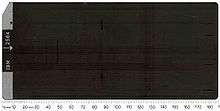IBM 6640
The IBM 6640 printer was one of the world's first office ink jet printers.[1] It was originally announced as the 46/40 but later renamed as 6640, as part of the Office System/6 word processing range in 1976.[2]


IBM claimed the 6640 combined quality printing with a very versatile and efficient automatic cut sheet-paper and envelope handling mechanic.[3]. It featured automatic selection of 10-pitch, 12-pitch or proportional spacing with up to five resident fonts.[3]
Documents to be printed were first prepared on either on magnetic cards by a Magnetic Card Selectric typewriter, or an Office System/6 console. Magnetic card stacks were loaded via a reader attached to the left side of the printer and the device could also communicate via BSC or SDLC protocols. A model of 6640 was without a Magnetic Card Deck but was hard-wired to an Office System/6 console for direct printing.
The printer itself had a large envelope drawer, and two paper drawers, each of which could handle a stack of paper up to approx. three inches thick, and up to 17 inches by 17 inches. Optional font cards were available, and installed on the planar located on the right side of the printer. Black ink was sprayed out of a single nozzle, broken into drops, and each drop was deflected by electromagnetic fields to form individual letters or symbols. Any drops not required to generate a letter were fed back into the ink system via the "gutter" for re-use. For example, a drop used for printing a letter was immediately followed by several "guard drops" that were deliberately deflected down into the gutter so as to avoid slip streaming.
The IBM 6640 used a dot structure of 24 x 40 (960 dots) to produce each character, where other products at that time used dot structures as low as 5 x 7 (35 dots) to produce a character. This was only possible due to IBM's use of microelectronics.[4]
There were two models:
- 6640-001 Announced in June 1976, this model could print at up to 92 characters per second.[3] It was withdrawn from marketing on November 1, 1982[5]
- 6640-002 Announced in 1979, this model could print at up to 184 characters per second.[3] It was withdrawn from marketing on November 1, 1982[5]
Both IBM and Diconix introduced a printer based on continuous inkjet technology but both products failed due to their cost and complexity.[6]
References
- Information, Reed Business (February 15, 1979). "Ink-jet printers zoom into the office market". New Scientist: 480.
- "History of IBM - 1976". IBM. Retrieved 2010-09-11.
- May, F.T. (1981). IBM Journal of Research and Development 25th Anniversary Edition. IBM. p. 745.
- Enterprise, I. D. G. (1977-07-04). Computerworld. IDG Enterprise.
- "ibm/serviceForConsultants/Service_For_Consultants_198312_Complete/13_Machine_Preface.pdf" (PDF).
- Engineers), IMechE (Institution of Mechanical (2001-08-22). Mail Technology: Evolution to e-Revolution. John Wiley & Sons. ISBN 978-1-86058-327-8.